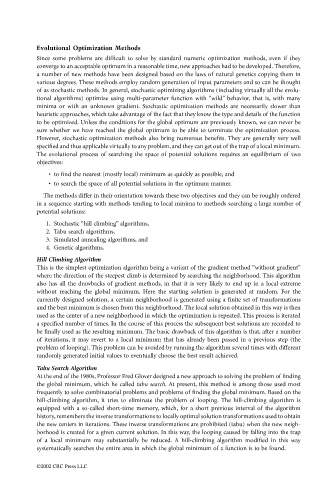Page 1008 - The Mechatronics Handbook
P. 1008
Evolutional Optimization Methods
Since some problems are difficult to solve by standard numeric optimization methods, even if they
converge to an acceptable optimum in a reasonable time, new approaches had to be developed. Therefore,
a number of new methods have been designed based on the laws of natural genetics copying them in
various degrees. These methods employ random generation of input parameters and so can be thought
of as stochastic methods. In general, stochastic optimizing algorithms (including virtually all the evolu-
tional algorithms) optimize using multi-parameter function with “wild” behavior, that is, with many
minima or with an unknown gradient. Stochastic optimization methods are necessarily slower than
heuristic approaches, which take advantage of the fact that they know the type and details of the function
to be optimized. Unless the conditions for the global optimum are previously known, we can never be
sure whether we have reached the global optimum to be able to terminate the optimization process.
However, stochastic optimization methods also bring numerous benefits. They are generally very well
specified and thus applicable virtually to any problem, and they can get out of the trap of a local minimum.
The evolutional process of searching the space of potential solutions requires an equilibrium of two
objectives:
• to find the nearest (mostly local) minimum as quickly as possible, and
• to search the space of all potential solutions in the optimum manner.
The methods differ in their orientation towards these two objectives and they can be roughly ordered
in a sequence starting with methods tending to local minima to methods searching a large number of
potential solutions:
1. Stochastic “hill climbing” algorithms,
2. Tabu search algorithms,
3. Simulated annealing algorithms, and
4. Genetic algorithms.
Hill Climbing Algorithm
This is the simplest optimization algorithm being a variant of the gradient method “without gradient”
where the direction of the steepest climb is determined by searching the neighborhood. This algorithm
also has all the drawbacks of gradient methods, in that it is very likely to end up in a local extreme
without reaching the global minimum. Here the starting solution is generated at random. For the
currently designed solution, a certain neighborhood is generated using a finite set of transformations
and the best minimum is chosen from this neighborhood. The local solution obtained in this way is then
used as the center of a new neighborhood in which the optimization is repeated. This process is iterated
a specified number of times. In the course of this process the subsequent best solutions are recorded to
be finally used as the resulting minimum. The basic drawback of this algorithm is that, after a number
of iterations, it may revert to a local minimum that has already been passed in a previous step (the
problem of looping). This problem can be avoided by running the algorithm several times with different
randomly generated initial values to eventually choose the best result achieved.
Tabu Search Algorithm
At the end of the 1980s, Professor Fred Glover designed a new approach to solving the problem of finding
the global minimum, which he called tabu search. At present, this method is among those used most
frequently to solve combinatorial problems and problems of finding the global minimum. Based on the
hill-climbing algorithm, it tries to eliminate the problem of looping. The hill-climbing algorithm is
equipped with a so-called short-time memory, which, for a short previous interval of the algorithm
history, remembers the inverse transformations to locally optimal solution transformations used to obtain
the new centers in iterations. These inverse transformations are prohibited (tabu) when the new neigh-
borhood is created for a given current solution. In this way, the looping caused by falling into the trap
of a local minimum may substantially be reduced. A hill-climbing algorithm modified in this way
systematically searches the entire area in which the global minimum of a function is to be found.
©2002 CRC Press LLC

